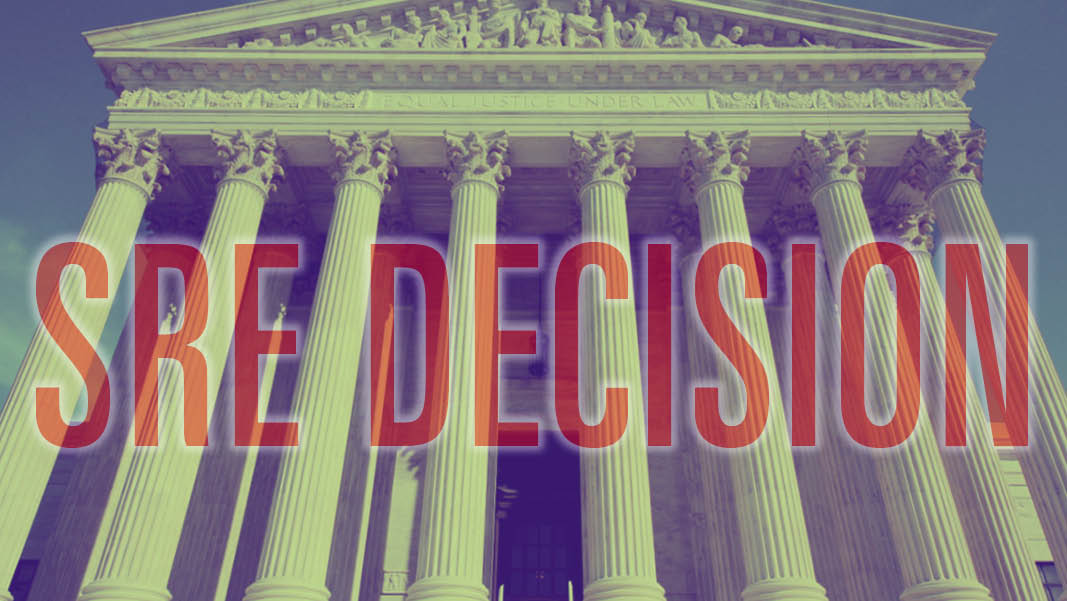Michael H. Levin
A maxim says, “The Supreme Court may not be right, but it’s final.” On June 25, in the latest chapter of the small-refiner exemptions (SREs) saga under the Renewable Fuels Standard (RFS), the Court issued a split decision whose majority appears to be neither right nor final. The closely-reasoned opinions undercut views of a united conservative Court bloc insensitive to legal or policy nuances.
By 6 to 3 the Court reversed, in HollyFrontier Refining v. Renewable Fuels Association, two unanimous Tenth Circuit rulings that only “narrow” SREs — where previous refiner extensions continuously have been maintained — are permissible. (See “Potential Game-Changer For RINs Waivers” and “RINs Hardship Waivers Get Day In (Supreme) Court” by the author, for background.) Instead the majority held that EPA may grant broad “stand-alone” SREs where a refinery’s previous extensions have lapsed or never been secured. The Tenth Circuit results could have limited SRE eligibility to less than a dozen small refineries. The Supreme Court’s reading could allow any small refiner to seek exemption “at any time.”
SREs relieve so-called “small refineries” (SRs) of the obligation to buy covering RINs for a specific biofuels-blending year. Unless these exempted volumes are “added back” to other refiners’ blend obligations — a step EPA has never yet taken — they also depress RINs demand and RINs prices. Thus HollyFrontier potentially involved billions of gallons of fuel exempted from annual RINs requirements, potentially representing hundreds of millions of dollars in payments per year by refineries to biofuels producers for their RINs. Indeed, RINs prices fell nearly 30% the day HollyFrontier was decided. One refiner’s gamble to defer covering RINs purchases till the price plunged seemingly paid off. But despite this decision, for reasons below, SREs should remain rare during the Biden-Harris years.
Question Before The Court
The sole question before the Court was whether the RFS phrase authorizing EPA to grant SRs “an extension of an exemption” requires those refiners’ previous “economic hardship” exemptions to have been continuously maintained, or whether SRs can receive an SRE where their previous exemptions lapsed. More generally: did Congress mean the number of SREs progressively to shrink so as to “funnel” SRs towards universal compliance with increasing blend obligations? Or did it mean SREs to act as “safety valves” that SRs can use if they face (say) tripled RINs prices, despite complying in previous years?
Justice Gorsuch for the majority found the RFS facially insufficient to support a “continuity of exemption” requirement. The word “extension,” he said, is not defined there. He agreed with RFA that Congress meant “an extension of time,” but not that this necessarily means a “continuous extension.” One of the word’s meanings, he noted with examples, is “to confer a benefit after it has expired.” If Congress meant SREs to be “successive” it could have said that. Moreover, he added, under EPA’s rules a refinery is “small” based on its previous year’s throughput — it can flash in or out of this preferred category if it over-expands but then cuts capacity. If a refinery’s basic status is inherently non-continuous, he suggested, SREs should be no different.
Justice Breyer agreed, presumably following his remarks at oral argument that given the “inherently volatile nature of the [RINs regime’s] market-based approach” it would be “odd” not to see SREs as safety valves. He also seems to have agreed that the presence of other SR safety valves does not determine whether SREs are “continuous” or “stand-alone.” It’s true SRs can “carry forward” RINs obligations to the following year, said the majority, but this merely imposes a double RINs-purchase obligation in Year Two. While EPA may lower annual blending targets to address regional or national “hardship,” it continued, this does not offer the individualized relief that SREs envision.
The majority rejected RFA’s legislative intent and public policy arguments as “surmise” not rooted in the statute. It appeared to view the Trump EPA’s five-fold expansion of historic-level SREs — regardless of high or low RINs costs — as ”normal fluctuation.“ It stated that forcing small refiners out of business if they miss one year of exemption could “disincentivize compliance” while undercutting RFS’s goal of ratchetting up biofuels production. Moreover, it noted, while Congress may have meant SREs to “sunset,” neither that word nor “sunset” intent appear in the RFS. In fact, it added, even by biofuels producers’ reading the RFS provides SRs at least one clear “safety valve,” since an SR that continuously maintains its SRE is exempt from RINs obligations forever. The majority said RFA never explained “why the least compliant refineries should be the most favored in this way.”
The Court concluded that because “both sides can offer plausible accounts of legislative purpose and sound public policy” but the RFS “nowhere commands a continuity requirement,” RFA had not shown that the Trump EPA’s “approval of [these three stand-alone] extension requests was in excess of the Agency’s statutory authority.”
The Dissent
Justice Barrett for the dissenters sharply disagreed. Since “something must exist to be extended,“ she began, “concluding that ‘extension’ means ‘continuation’ should be an easy call, but the Court forgoes the obvious answer.” The “ordinary meaning” of “extension,” she continued — not the majority’s “outlier definition” — is “something prolonged without interruption.” A hotel guest who returns after five years would not be said to “extend’ her previous booking. An expired newspaper subscription would not normally be called “extended” when renewed. The Court’s precedents require it to follow this “natural” reading, she declared. Otherwise an SR could ask in 2040 to ”extend” an SRE it held only for Renewable Volume Obligation (RVO) Year 2010.
Barrett’s dissent then endorsed RFA’s “funnel” positions. Congress granted stand-alone waivers of blending obligations in nearby provisions, she noted — but not for SREs. It required “requests for an extension of the exemption” to consider a 2008 U.S. Department of Energy exemption study; but the Court’s approach nonsensically meant EPA would have to assess a new Year 2050 SRE request in light of a 40-year-old study. That RFS elsewhere provides broad “hardship” relief indicates Congress did not mean to authorize such relief through SREs. SRs’ ability to petition for exemptions “at any time” merely addresses when they may file a request, not whether they’re eligible to receive an SRE. In fact, she noted, this clause grants small refineries additional flexibility — it allows them to petition before (not just after) annual blending targets are set. Moreover, she added, the majority distorts RFS’ incentive regime: narrow SREs provide a “grace period” for refineries to reach compliance, not the perverse “permanent waiver” the Court assumes. That SREs “give small refineries an initial runway rather than a down-the-road safety valve,” she concluded, “is not at all odd if, as RFA asserts, Congress intended to funnel all refineries into eventual compliance.”
Takeaways
The opinion is notable for three additional reasons.
- First, it shows how Supreme Court votes may be fluid rather than fixed by labels. Justice Breyer, Clinton appointee, joined the “conservative majority.” Justice Barrett, Trump appointee, forcefully disagreed with that majority. Her dissent was her first since joining the Court. It also appears to be the first all-female dissent in the Court’s history.
- Second, HollyFrontier may have prevailed on the “safety valve” issue, but seems certain to lose its war. The majority reversed the Tenth Circuit only “To the extent it vacated EPA’s [SRE approval] orders on this ground.” That Circuit struck down the Trump EPA’s HollyFrontier SREs on two further, independent grounds: they ignored agency findings that SRs typically pass RINs costs through to their customers, and they interpreted “hardship” to include not just RINs costs but general economic conditions. It would be extraordinary if a court that unanimously reached these conclusions did not affirm its SRE denials on such remaining grounds.
- Finally, HollyFrontier found the RFS ambiguous on whether continuous “narrow” SREs are required. As Justice Gorsuch noted, under the Court’s Chevron doctrine such ambiguity normally would entitle any reasonable EPA interpretation to judicial deference. But because three Trump EPA “broad” SREs were at issue and the Biden administration had switched positions to support “narrow” SREs, the government disclaimed deference for that Trump interpretation. No such government disclaimer would be made for a Biden-endorsed “continuity” rule.
This outcome opens several doors for the Biden EPA to reject the 60-odd SREs still before it. It could formally — as it already has by informal announcement — reject “stand-alone” SREs and adopt a “continuous” interpretation the HollyFrontier majority called “equally plausible.” It could presume per past agency studies that SRs pass through their RINs costs, placing a heavy burden on SRE applicants to demonstrate (not just assert) that’s not the case. It could affirm (as even the Trump EPA suggested when denying a raft of retroactive ”gap-filling” SRE petitions) that “hardship” does not apply to SRs who managed to comply during numerous prior RINs-cost-fluctuation years. It also could redefine “small” by requiring (say) 3 years’ average 75,000 barrels/year throughput, rather than this throughput for a single year. HollyFrontier does not limit any of these.
Meanwhile, a flanking action now is live. In RFA v EPA (D.C Circuit, No. 19-1220, filed Oct. 22, 2019), biofuels producers challenged the Trump EPA’s blanket grant of 31 SREs, raising all three objections later affirmed by the Tenth Circuit. That case was suspended till a decision in HollyFrontier. Unlike HollyFrontier, whose reach technically was limited to seven Tenth Circuit states, it is “of national import” and will apply nationally. It’s also unlike a clutch of other cases challenging grants or denials of individual SREs — including challenges to three Trump ”midnight SREs” granted January 19 — that voluntarily have been sent back to the agency because the Trump EPA concededly “did not analyze determinative legal questions regarding whether [the] refineries qualified to receive [SRE]extensions.”
This case soon will move forward. It’s where the SRE spotlight likely will turn next.
Mike Levin, a BioCycle Contributing Editor, is managing member of the virtual law firm Michael H. Levin Law Group, PLLC (Washington DC) and a principal in NLGC LLC and Solar Shield LLC, which respectively focus on capital formation for renewable energy projects and optimization/development of rooftop PV systems in the District of Columbia. From 1979-1988 he was National Regulatory Reform Director at the U.S. EPA. Some quotations in this article are edited for brevity.













